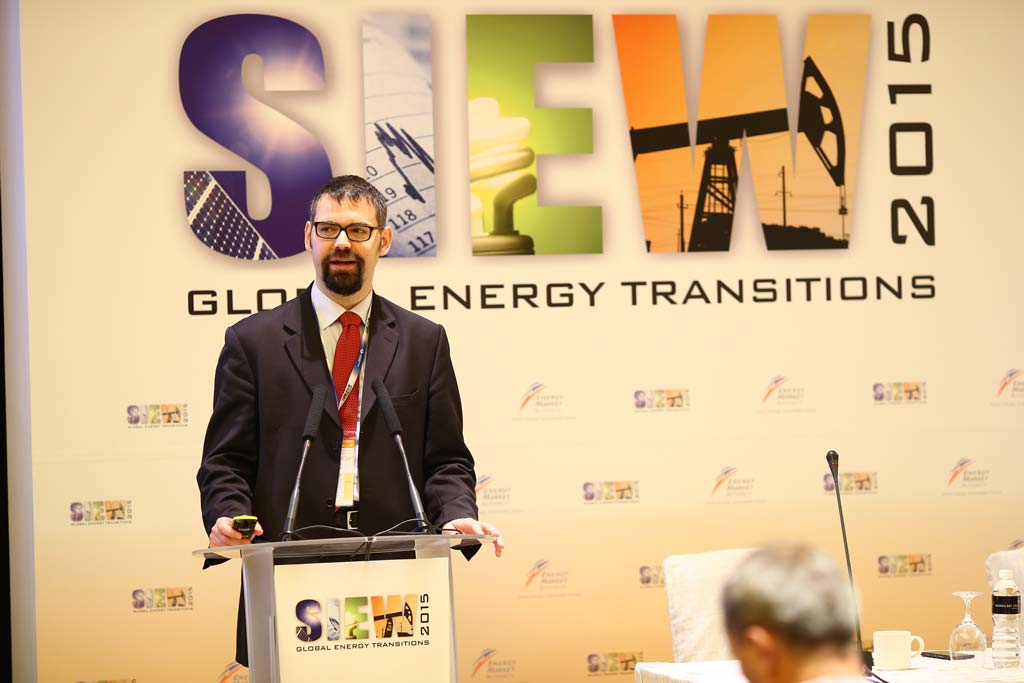
Laszlo Varro, Head of Gas, Coal, Power, International Energy Agency (IEA) addresses The Energy Outlook for Southeast Asia: The Importance of the Power Sector roundtable at SIEW 2015
By Eng Zi Guang
Southeast Asian countries must invest in infrastructure, foster cooperation and ensure good governance of the power sector to meet the rapidly rising demand for electricity as their economies grow, panellists said on Thursday at Singapore International Energy Week 2015.
Despite the differences among the various countries in the region, many face a common issue as an estimated 120 million people still do not have access to electricity, the panellists said at a roundtable discussion on the challenges facing the power sector in Southeast Asia.
There is still “massive work to be done to ramp up the power supply”, said Laszlo Varro, head of gas, coal and power at the International Energy Agency (IEA).
With economic growth driving the need for more electrification, the demand for power in the region will grow significantly and require substantial investment in generation and transmission assets, the panellists said.
In contrast to most other regions, coal will be the fastest-growing source for electricity generation in Southeast Asia and overtake gas and oil as the primary fuel for power plants, they said. As most of the planned investment is focused on outdated subcritical coal technology, these projects will be a significant contributor to carbon emissions from the region, they added.
Growth in renewable generation is expected to be rather modest, with its deployment constrained by uncertainties over energy policies, financing and market structure, the panellists said.
Moves to address and clarify these issues could boost renewable development in the next five years by up to 20%, said Michael Waldron, an analyst at the IEA.
“While variability of renewables is a challenge that energy systems can learn to adapt to, variability of policies – especially retroactive changes – pose a far greater risk,” he said.
While there is no single solution to the challenges, the panellists agreed that good governance is a must for the region’s power sector development.
Emphasising the differences within Southeast Asia, Adrian Kemp, a partner at HoustonKemp Economists, said the lowest-cost option to increase electrification in countries such as Indonesia and The Philippines may no longer be the traditional model of a large power plant connected to a centralised grid.
For some of the other countries, said IEA analyst Matthew Wittenstein, there could be benefits from greater interconnectivity of national or regional grids. Such coordination would allow them to take full advantage of their respective renewable resources, such as hydropower in Laos, for the greater good of the region.
But he warned that “inadequate system planning or insufficient real-time management capabilities could cause cross-border blackouts” and emphasised the importance of good governance and a rules-based framework led by strong and independent regulators to overcome the challenges of integration.
About Singapore International Energy Week (SIEW)
In its 8th edition, Singapore International Energy Week is the premier platform in Asia for energy insights, partnerships and dialogue, bringing together the world’s leading conferences, exhibitions and roundtables in one week and one location. SIEW enriches the global energy conversation by convening political, business, academic and energy industry thought-leaders to define and advance the world’s energy challenges, solutions and actions across the spectrum of oil and gas, clean and renewable energy, and energy infrastructure financing.
Please visit www.siew.gov.sg for more information.
About the Energy Market Authority
The Energy Market Authority (EMA) is a statutory board under Singapore’s Ministry of Trade and Industry. Our main goals are to ensure a reliable and secure energy supply, promote effective competition in the energy market and develop a dynamic energy sector in Singapore. Through our work, we seek to forge a progressive energy landscape for sustained growth.
Please visit www.ema.gov.sg for more information.